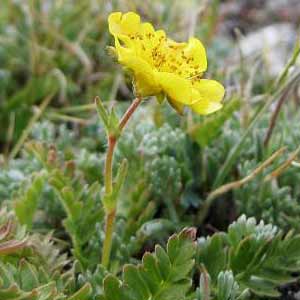Geum rossii
(synonym of Geum rossii var. depressum)
Geum rivale
Ross' avens
benoîte des ruisseaux, chocolate-root, purple avens, water avens
4–28 cm, glabrous or downy, hairs to 1 mm, sometimes septate-glandular.
30–85 cm, sparsely downy to scattered-hirsute proximally, downy distally.
basal 3–13 cm, blade pinnate to interruptedly pinnate, major leaflets 13–26, alternating with 0–14 minor ones, terminal leaflet slightly larger than major laterals;
cauline 0.7–2 cm, stipules adnate to leaf, indistinguishable from pair of lobes, blade bractlike, not resembling basal, alternate, simple, pinnatifid to 3-fid.
basal 6–40 cm, blade interruptedly pinnate, major leaflets 5–7, mixed with 7–14 minor ones, terminal leaflet slightly larger than major laterals;
cauline 2–10 cm, stipules ± free, 7–18 × 5–9 mm, blade pinnate to 3-foliolate.
1–3(–4)-flowered.
2–8-flowered.
woolly, sometimes glandular.
densely downy, some hairs glandular.
erect;
epicalyx bractlets 1.5–7 mm;
hypanthium green, slightly purple-tinged to strongly purple;
sepals erect to erect-spreading, 3–10 mm;
petals spreading, yellow, obovate to nearly orbiculate, 5–12(–17) mm, longer than sepals, apex broadly rounded to irregularly emarginate.
nodding;
epicalyx bractlets 2–4 mm;
hypanthium greenish maroon to maroon;
sepals erect, 7–10 mm;
petals erect, yellow, suffused with purple and purple-veined, spatulate-obovate, 8–10 mm, ± equal to sepals, apex rounded, truncate, or shallowly emarginate.
sessile, glabrous.
on 4–10 mm stipes, densely bristly.
wholly persistent, not geniculate-jointed, 2–5(–10) mm, apex not hooked, glabrous throughout or pilose only at base.
geniculate-jointed, proximal segment persistent, 5–9 mm, apex hooked, stipitate-glandular, bristles on basal 1/2, distal segment deciduous, 3–4.5 mm, pilose except apical 1 mm.
= 56.
= 42.
Geum rossii
Geum rivale
The variability accommodated here in Geum rossii was distributed by earlier monographers such as P. A. Rydberg (1913b) and F. Bolle (1933) among a half dozen species. W. Gajewski (1957) reduced them to two species, G. rossii and G. turbinatum; most recent taxonomists have recognized the two taxa as subspecies or varieties of a single species. The large geographic discontinuity between the Rocky Mountain and arctic ranges makes it easy for those wishing to follow this tradition. No one morphologic character or combination of characters neatly separates the arctic plants from those of the Rockies.
Where their ranges overlap in Alaska, Geum rossii hybridizes with G. calthifolium to form sterile plants known as G. ×macranthum (Kearney ex Rydberg) B. Boivin; see discussion under 4. G. schofieldii.
(Discussion copyrighted by Flora of North America; reprinted with permission.)
Geum rivale forms hybrids with three other species of the genus in North America: G. ×aurantiacum Fries ex Scheutz [G. aleppicum × G. rivale] is reported from Alberta, Ontario, Montana, and New York; G. ×pervale B. Boivin [G. macrophyllum var. perincisum × G. rivale] is known from Alberta, Ontario, Quebec, and Saskatchewan; and G. ×pulchrum Fernald [G. macrophyllum var. macrophyllum × G. rivale] is reported from Ontario, Quebec, Idaho, New Hampshire, and Vermont. The hybrids generally have the habit and foliage of G. rivale but exhibit shallower hypanthia, spreading sepals, and pure yellow, clawed, obovate to suborbiculate petals. The glandular hairs on the pedicels usually lack the dark tips seen in G. rivale. Given that the morphologic differences among the three named hybrids are vague, suspected hybrid specimens are best determined while in the field where collectors can note the proximity of the hybrids to their supposed parental species.
(Discussion copyrighted by Flora of North America; reprinted with permission.)
- Local floras:
BC,
OR,
WA
- Local Web sites:
CalFlora,
CalPhotos,
Flora NW,
PNW Herbaria
WildflowerSearch
iNaturalist (observations)
USDA Plants Database
- LBJ Wildflower Center
- SEINet
- Plants of the World Online
- Encyclopedia of Life
- Wikipedia
- Google Image Search
- Local floras:
BC,
WA
- Local Web sites:
Flora NW,
Go Botany,
IL Wildflowers,
MD Biodiversity,
MI Flora,
MN Wildflowers,
PNW Herbaria
WildflowerSearch
iNaturalist (observations)
USDA Plants Database
- LBJ Wildflower Center
- SEINet
- Plants of the World Online
- Encyclopedia of Life
- Wikipedia
- Google Image Search
